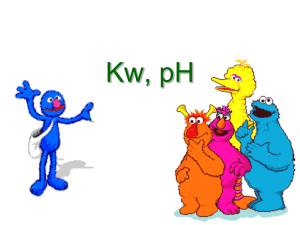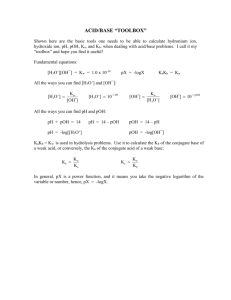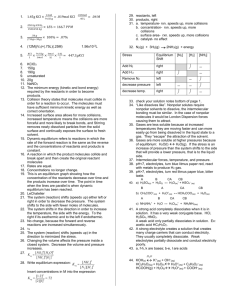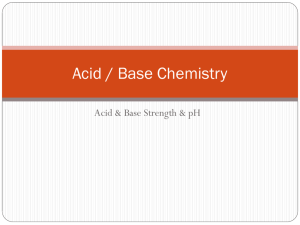H + - Paws.wcu.edu.
advertisement
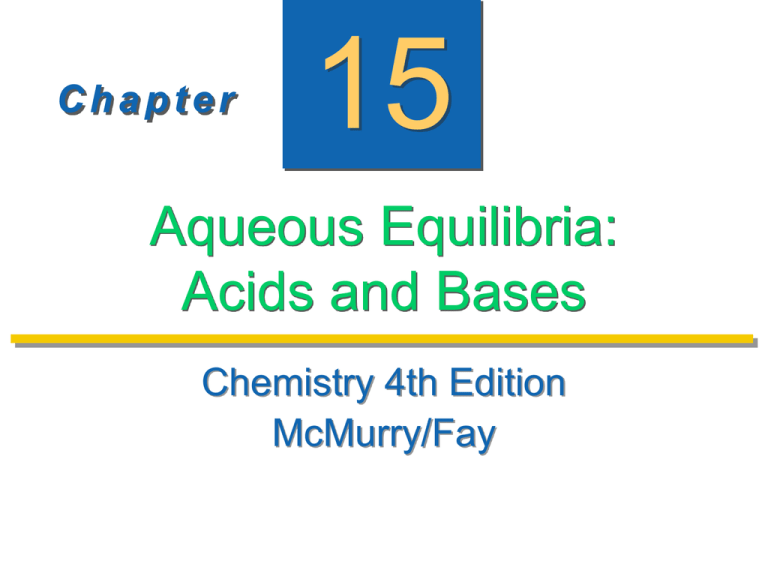
Chapter 15 Aqueous Equilibria: Acids and Bases Chemistry 4th Edition McMurry/Fay Acid–Base Concepts 01 Arrhenius Acid: Substance which dissociates in water to form hydrogen ions (H+) in solution: OLD HA (aq) H+ (aq) + A– (aq) definitions Ex: HCl(aq) + H2O(l) H3O+(aq) + Cl–(aq) Arrhenius Base: Substance that dissociates in water, or reacts with water, to form hydroxide ions (OH–): MOH (aq) M+ (aq) + OH– (aq) Ex: KOH(aq) K+(aq) + OH–(aq) Acid–Base Concepts NEW definitions 02 Brønsted-Lowry Acid: Substance that can donate H+ Brønsted-Lowry Base: Substance that can accept H+ (often has a lone pair of electrons) : Compounds whose formulas differ only by a proton are said to be conjugate acid–base pairs. Brønsted–Lowry Definition Give products, and identify the Brønsted–Lowry acid, base, and conjugate acid/base. base .. HBr + H2O: acid acid ..base – :NH2 + CH3OH acid HNO3 acid ..base + PH3 base H2O + tBuO– conj. base – Br conj. acid H3O+ + conj.base conj. acid CH3O– + NH3 NO3– tBuOH + HO– + PH4+ Acid–Base Concepts 03 Example hydrochloric acid Strong Acid HCl (aq) no HA (strong electrolyte) Weak Acid Very Weak Acid acetic acid CH3CO2H water or H2O no H3O+ A- alcohol CH3CH2OH (non-electrolyte) Acid–Base Concepts 04 Know these Acids and Bases! Strong Acids Strong Bases HCl Hydrochloric Acid NaOH Sodium Hydroxide HNO3 Nitric Acid KOH Potassium Hydroxide H2SO4 Sulfuric Acid Weak Acids HF Hydrofluoric Acid CH3CO2H Acetic Acid Ca(OH)2 Calcium Hydroxide Weak Bases NH3 Ammonia Dissociation of Water Water act as both an acid and as a base: 2 H2O(l) H3O+(aq) + OH–(aq) 01 What is the position of this equilibrium? This is called the auto-ionization of water. H2O(l) + H2O(l) H3O+(aq) + OH–(aq) H+(aq) + OH–(aq) H2O(l) Write the equilibrium expression for this reaction ( called the ion product constant for water ): KKwc = [H+] [OH–] = 1.0 x 10–14 at RT only The Kc for water called “Kw”. What is the equilibrium constant value? (Are products or reactants favored?) Kw is very small, so this reaction mixture will be nearly ALL starting material. Dissociation of Water 02 H2O(l) H+(aq) + OH–(aq) By the balanced equation, we see [H+] = [OH–]. So if: [H+] [OH–] = 1.0 x 10–14 (at RT) then [H+] = 1.0 x 10-7 log [H+] = -7 -log [H+] = 7 We will call the negative log of the H+ concentration the pH of the aqueous solution. The pH of pure water is 7, which is the neutral point. pH – A Measure of Acidity The pH of a solution is the negative log of the H+ concentration: pH = –log [H+] Neutral solutions: [H+] = 1.0 x 10–7 M, pH = 7.00 [OH-] = 1.0 x 10-7 M also Acidic solutions: [H+] > 1.0 x 10–7 M, Example: 0.001 M HCl [H+] = 1.0 x 10-3 pH < 7.00 [H+] < 1.0 x 10–7 M, pH > 7.00 Basic solutions: pH = 3 01 Acid/Base Concepts: pH Scale Fig on p. 621 of text Remember that pH is a log scale. If pH of coffee is 5 and pH of vinegar is 3, then vinegar is 100 times more acidic than coffee. pH 5: [H+] = 10-5 pH 3: [H+] = 10-3 x 100 pH Calculations 03 1. The concentration of aqueous nitric acid (HNO3) at RT is 0.045M. What is the pH of this solution? pH = -log [H+] = -log (0.045) = 1.35 2. A basic solution has a pH of 10.5. What is [H+]? [H+] = inv log (-10.5) = 3.16 x 10-11 M strong acid pH Calculations 3. In a solution where the [H+] = 4.8 x 10-12M, find: a) the OH– conc. b) the pH (Hint: use Kw which is an equilibrium constant.) [H+] x [OH–] = 1.0 x 10-14 [OH–] = 1.0 x 10-14 / [H+] = 1.0 x 10-14 / 4.8 x 10-12 = 2.08 x 10-3 M pH = -log(4.8 x 10-12) = 11.3 03 pOH – Base Concentration pH negative log of [H+]: Define: 01 pH = –log [H+] pOH negative log of [OH–]: pOH = –log [OH–] Since then [H+] x [OH-] = 1.0 x 10-14 = Kw pH + pOH = 14 If pH is 3.4, what is the pOH? pH + pOH = 14 pOH = 11.6 If pH is 12.7, what is pOH? 12.7 + pOH = 14 pOH = 1.3 Dissociation of Water 03 The concentration of OH– ions in a certain household ammonia cleaning solution is 0.0025 M. Calculate pH. 1. Use Kw to find the H+ concentration, then calc. pH. - or - 1. [H+] x [OH-] = 1.0 x 10-14 = Kw [H+] = 1x10-14/(0.0025) = 4.0 x 10-12 pH = -log(4.0x10-12) = 11.40 Dissociation of Water 03 The concentration of OH– ions in a certain household ammonia cleaning solution is 0.0025 M. Calculate pH. 1. Use Kw to find the H+ concentration, then calc. pH. - or 2. Calculate pOH, then find pH (pH + pOH = 14) 2. pOH = -log(0.0025) = 2.60 pH + pOH = 14 pH = 14 – pOH = 11.40 Acid / Base Review Strong acids and bases ionize completely in water: HA + H2O A- (aq) + H3O+ (aq) at equilib: ~0% ~100% Weak acids and bases ionize only slightly in water: HA + H2O A- (aq) + H3O+ (aq) at equilib: 98.5% or 99.96% 1.5% 0.04% Solutions of weak acids and bases contain ionized AND non-ionized species. Acid / Base Review Write balanced equations for the dissociation of each of the following Brønsted–Lowry acids. (a) H2SO4 H2SO4 (aq) + H2O(l) HSO4– (aq) + H3O+ (aq) better (b) HSO4– HSO4– (c) H4N+ H4N+ (aq) + H2O(l) SO42– + H+ H3N (aq) + H3O+ (aq) Acid / Base Review Write balanced equations for the reaction of each of the following Brønsted–Lowry bases. (a) NaOH NaOH (aq) + H+ (b) NH3 NH3 (aq) + H2O(l) weak base strong base Na+ (aq) + H2O (l) H4N+ (aq) + OH– (aq) Strength of Acids and Bases 02 If an acid is strong (ex: HCl), its conjugate base (Cl–) has no measurable base strength. A weak acid (ex: HF) has a conjugate base (F–) that is a weak base. H3O+ is the strongest acid that can exist in aqueous solution. OH– ion is the strongest base that can exist in aqueous solution. Indicators – Color Depends on pH Acid Dissociation Constants 01 Acid Dissociation Constant: the equilibrium constant for the ionization of an acid. H3O+(aq) + A–(aq) HA(aq) + H2O(l) Or simply: H+(aq) + A–(aq) HA(aq) [H ][A ] Ka [HA] Base Dissociation Constants 01 Base Dissociation Constant (Kb): the equilibrium constant for the reaction of a base w/ a proton. NH4+(aq) + OH–(aq) NH3(aq) + H2O(l) [NH4 ][OH ] Kb [NH3] Weak Acid Dissociation Constants ACID Ka HF STRONGER ACID HNO2 C9H8O4 (aspirin) HCO2H (formic) C6H8O6 (ascorbic) C6H5CO2H (benzoic) CH3CO2H (acetic) HCN C6H5OH (phenol) WEAKER ACID 7.1 x 10 –4 4.5 x 10 –4 3.0 x 10 –4 1.7 x 10 –4 8.0 x 10 –5 6.5 x 10 –5 1.8 x 10 –5 4.9 x 10 –10 1.3 x 10 –10 CONJ. BASE F– WEAKER BASE NO2 – C9H7O4 – HCO2 – C6H7O6 – C6H5CO2 – CH3CO2 – CN – C6H5O – STRONGER CONJ. BASE Kb 1.4 x 10 –11 2.2 x 10 –11 3.3 x 10 –11 5.9 x 10 –11 1.3 x 10 –10 1.5 x 10 –10 5.6 x 10 –10 2.0 x 10 –5 7.7 x 10 –5 Strength of Acids and Bases 04 Stronger acid + stronger base weaker acid + weaker base Predict the direction of the following: HNO2(aq) + CN–(aq) HF(aq) + NH3(aq) HCN(aq) + NO2–(aq) F–(aq) + NH4+(aq) Percent Dissociation Concentration Dependence: 10 Base Ionization Constants BASE Kb C2H5NH2 (ethylamine) 5.6 x 10 –4 CH3NH2 (methylamine) 4.4 x 10 –4 C8H10N4O2 (caffeine) 4.1 x 10 –4 NH3 (ammonia) 1.8 x 10 –5 C5H5N (pyridine) 1.7 x 10 –9 C6H5NH2 (aniline) 3.8 x 10 –10 NH2CONH2 (urea) 1.5 x 10 –14 CONJ. ACID C2H5NH3+ CH3NH3+ C8H11N4O2+ NH4+ C5H6N+ C6H5NH3+ NH2CONH3+ 02 Ka 1.8 x 10 –11 2.3 x 10 –11 2.4 x 10 –11 5.6 x 10 –10 5.9 x 10 –6 2.6 x 10 –5 0.67 Note that the positive charge sits on the nitrogen.
